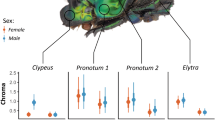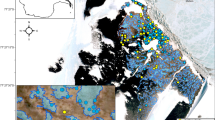Abstract
This study investigated the influence of environmental factors on the foraging cycle, breeding activity, settlement and growth of the opisthobranch Hydatina physis using laboratory trials and field observations. Results showed that H. physis follows a nocturnal circadian rhythm mediated by photic intensity and modulated by food availability. The adults foraged between 1900 and 0530 h, with an activity peak between 2000 and 2200 h, and remained inactive and burrowed in the sand during the day. This pattern was clearly influenced by cloud cover, rain and laboratory manipulated light:dark cycle. The reproduction of H. physis was primarily influenced by the lunar cycle. For 4 consecutive months, hermaphroditic reciprocal copulation, preceded by pre-copulatory courtship behaviour, occurred at night 5–7 d before the full moon. Spawning occurred 3–5 d later for up to 5 consecutive nights, the egg mass gradually decreasing in size with each spawning. An overcast sky or rain prevented or delayed both copulation and egg release. Settlement of veligers was largely influenced by the nature of the substrate. In multiple-choice experiments, settlement occurred predominantly on sand containing cirratulid polychaetes. The juveniles reached ca. 3.9 mm in shell length after 5.5 months growth.
Similar content being viewed by others
References
Abbott R. T. and Dance S. P. (2000). Compendium of Seashells. Odyssey Publishing, California, USA, 411
Allan J. (1959). Australian Shells, with Related Animals Living in the Sea, in Freshwater and the Land. Georgian House, Melbourne, Australia, 487
Aspey W. P. and Blankenship J. E. (1976). Aplysia behavioral biology: II. Induced burrowing and swimming in A. brasiliana by burrowed conspecifics. Behavioral Biology 17: 301–312
Audesirk T. E. (1979). A field study of growth and reproduction in Aplysia californica. Biological Bulletin 157: 407–421
Bech M. (1992). Settling behaviour of Chicoreus ramosus (Linneaus, 1758) with notes on sea farming. Phuket Marine Biological Center Special Publication 11: 45–50
Beeman R. D. (1977). Gastropoda: Opisthobranchia. In: Giese, A. C. and Pearse, J. S. (eds) Reproduction of Marine Invertebrates, Chapter 2, Vol. IV, Molluscs: Gastropods and Cephalopods, pp 115–179. Academic Press, New York, USA
Buckland-Nicks J., Gibson G. and Koss R. (2002). Phylum Mollusca: Gastropoda. In: Young, C. M., Sewell, M. A., and Rice, M. E. (eds) Atlas of Marine Invertebrate Larvae, Chapter 14, pp 261–265. Academic Press, New York, USA
Carefoot T. H. (1967). Growth and nutrition of Aplysia punctata feeding on a variety of marine algae. Journal of the Marine Biological Association of the United Kingdom 47: 565–589
Chia F. S. (1971). Oviposition, fecundity and larval development of three sacoglossan opisthobranchs from the Northumberland coast, England. Veliger 13: 319–325
Chia F. S. and Skeel M. (1973). The effect of food consumption on growth, fecundity and mortality in a sacoglossand opisthobranch, Olea hansineensis. Veliger 16: 153–158
Christensen H. (1977). Feeding and reproduction in Precuthona peachi (Mollusca: Nudibranchia). Ophelia 16: 131–142
Eyster L. S. (1979). Reproduction and developmental variability in the opisthobranch Tenellia pallida. Marine Biology 51: 133–140
Gibson D. G. and Chia F. S. (1989). Developmental variability (pelagic and benthic) in Haminoea callidegenita (Opisthobranchia: Cephalaspidea) is influenced by egg mass jelly. Biological Bulletin 176: 103–110
Gohar H. A. F. and Soliman G. N. (1963). The biology and development of Hexabranchus sanguineus (Ruppell and Leuckart) (Gastropoda, Nudibranchia). Publications of the Marine Biological Station, al-Ghardaqa, Red Sea 12: 219–247
Gurin S. and Carr W. E. (1971). Chemoreception in Nassarius obsoletus: “the role of specific stimulatory proteins”. Science 174: 293–295
Hadfield M. G. (1978). Metamorphosis in marine molluscan larvae: an analysis of stimulus and response. In: Chia, F. S. and Rice, M. E. (eds) Settlement and Metamorphosis of Marine Invertebrate Larvae, pp 165–175. Elsevier/North Holland Biomedical Press, Amsterdam, The Netherlands
Hadfield M. G. and Switzer-Dunlap M. (1984). Opisthobranchs. In: Tompa, A. S., Verdonk, N. H. and Van den Biggelaar, J. A. M. (eds) The Mollusca, Vol. 7, Reproduction, pp 209–350. Academic Press, New York, USA
Harris L. G. (1975). Studies on the life history of two coral-eating nudibranchs of the genus Phestilla. Biological Bulletin 149: 539–550
Heslinga G. A. (1981). Larval development, settlement and metamorphosis of the tropical gastropod Trochus niloticus. Malacologia 20: 349–357
Kilburn R. and Rippey E. (1982). Seashells of Southern Africa. Macmillan South Africa Publishers, Johannesburg, South Africa, 130
Kupfermann I. (1967). Stimulation of egg laying: possible neuroendocrine function of bag cells of abdominal ganglion on Aplysia californica. Nature 216: 814–815
Lalli C. M. and Wells F. E. (1973). Brood protection in an epipelagic thecosomatous pteropod, Spiratella (“Limacina”) inflata (D’Orbigny). Bulletin of Marine Science 23: 933–941
Marcus E. and Marcus E. (1967). Tropical American Opisthobranchs. In: Marcus, E. and Marcus, E. (eds) American Opisthobranch Mollusks, pp 3–137. University of Miami Institute of Marine Sciences, Florida USA
Ostergaard J. M. (1950). Spawning and development of some Hawaiian marine gastropods. Pacific Science 4: 75–115
Rudman W. B. (1972). The anatomy of the opisthobranch genus Hydatina and the functioning of the mantle cavity and alimentary canal. Zoological Journal of the Linnean Society 51: 121–139
Schaefer K. (1996). Review of data on cephalaspid reproduction, with special reference to the genus Haminaea (Gastropoda, Opisthobranchia). Ophelia 45: 17–37
Scheltema R. S. (1961). Metamorphosis of the veliger larvae of Nassarius obsoletus (Gastropoda) in response to bottom sediment. Biological Bulletin 120: 92–109
Schmekel L. (1971). Histologie und Feintruktur der Genitalorgane von Nudibranchiern (Gastropoda, Euthyneura). Zeitschrift fur Morphologie der Tiere 69: 115–183
Thompson T. E. (1958). The natural history, embryology, larval biology and post-larval development of Adalaria proxima (Alder and Hancock) (Gastropoda, Opisthobranchia). The Royal Society of London. Philosophical Transactions Series B 242: 1–58
Thompson T. E. (1976). Biology of Opisthobranch Molluscs, Vol I. John Wright & Sons Ltd, Bristol, UK, 207
Thorson, G. (1957). Bottom communities (sublittoral and shallow shelf). In: Hedgpeth, J. W. (ed.), Treatise on Marine Ecology and Paleontology. Vol. 1. Ecology Geology Society American Memoirs 67: 461–534
Todd C. D. (1979). The population ecology of Onchidoris muricata (Muller) in relation to size, age and spawning (Gastropoda: Opisthobranchia). Journal of Molluscan Studies 44: 190–199
Widdows J. (1991). Physiological ecology of mussel larvae. Aquaculture 94: 147–163
Wirtz P. (1999). Hydatina physis (Mollusca, Gastropoda, Opisthobranchia) of the Azores. Arquipélago Life and Marine Sciences 17: 97–100
Author information
Authors and Affiliations
Corresponding author
Rights and permissions
About this article
Cite this article
Hamel, JF., Mercier, A. Factors regulating the breeding and foraging activity of a tropical opisthobranch. Hydrobiologia 571, 225–236 (2006). https://doi.org/10.1007/s10750-006-0247-4
Received:
Revised:
Accepted:
Published:
Issue Date:
DOI: https://doi.org/10.1007/s10750-006-0247-4




